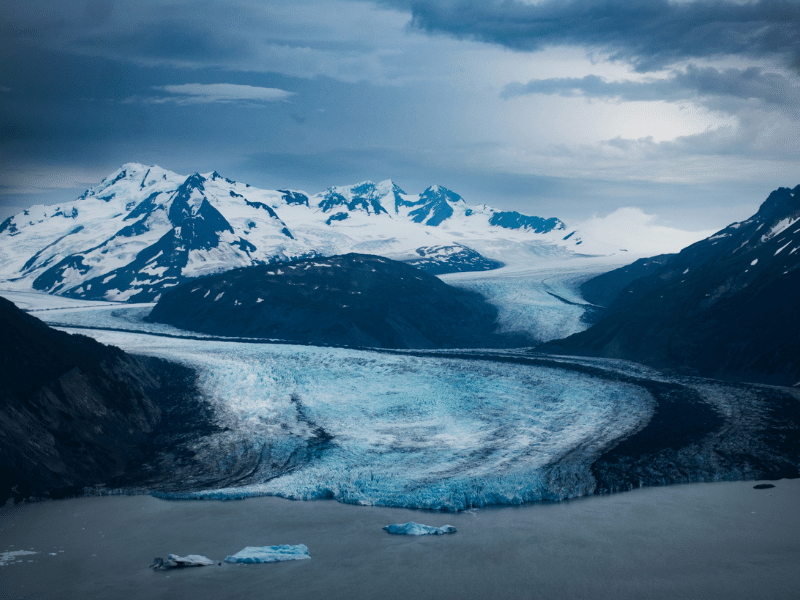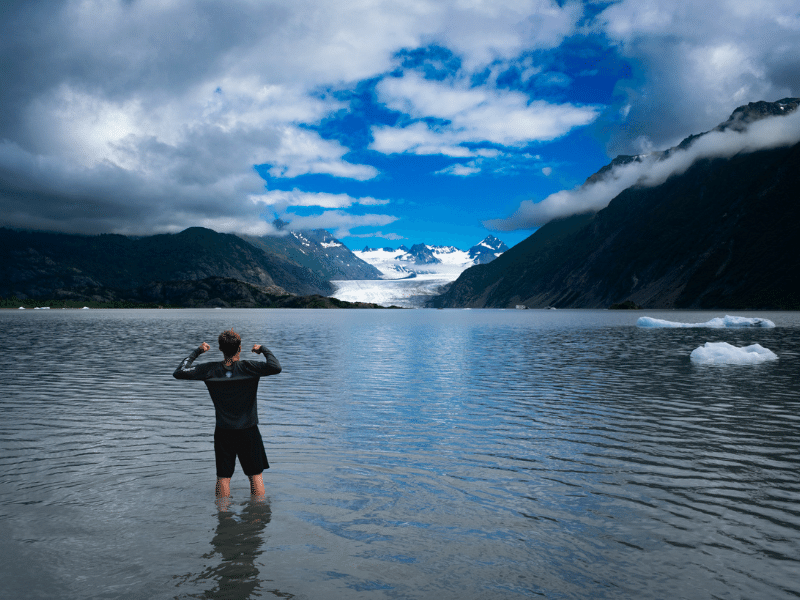This is the second entry of “Lessons from Alaska,” a series of posts written by Putney leader Braelei Hardt, who recounts several pivotal moments during their time leading our Middle School Alaska program and our Columbia Climate School program in Alaska. Enjoy their accounts of these transformational experiences. Click here to see the first post.
A Boy and His Glacier
The first time I saw Exit Glacier, it was from the distant vantage point of an end-of-road observation deck. It offered a sprawling view of the icy giant, commanding and remote in its inter-mountain nook just outside of Seward, Alaska. Now, leading a group of middle schoolers up the winding trail to Exit Glacier’s frozen edge, I was about to experience this Alaskan wonder in a way I never had before. Among my charges was a 14-year-old student, a bundle of energy with a penchant for mischief, who had seemed uninterested and disengaged during our time so far. The day broke with a chill that promised adventure, and we set off with the glacier towering in the distance. The boy lagged behind and I wondered, not for the first time, what it might take to breach the walls of this apparent apathy.
Halfway up, we paused at an overlook, a natural balcony offering a front-row seat to the unfolding narrative of the glacier’s retreat. Over labored breath I gestured toward the marker posts lining the bottom of the valley below. I pointed out the signpost for 2019, where the glacier’s edge had rested on my first visit only a few years prior. This student followed my gaze to the sign, now well over 300 feet from where the ice now lay. “That’s like, an entire football field,” he muttered, a flicker of curiosity in his eyes.

Our journey to the glacier’s base was unlike any I had experienced before. The terrain had changed dramatically from my last visit, the ice having retreated farther than I expected, revealing a rugged and treacherous landscape of steep rock falls. When we finally paused to gear up with crampons and ropes, our ice climbing guide apologized for the long, exhausting trek. “When I started guiding here 10 years ago, we could reach the ice in under an hour,” she explained. Our hike had taken nearly three.
The higher we climbed, the more the student’s demeanor shifted. His earlier bravado waned, replaced by a contemplative silence. When our guide took us to a high overlook, the valley sprawling below us, the student stopped, his gaze fixed on the horizon where the ice met the sky. The enormity of the scene before us seemed to strike a chord in him. He stood there, motionless, as if time had paused. The glacier, in all its stark, frozen glory, demanded attention—and for the first time, he obliged.
I allowed him a moment of silence, approaching only when the others had begun to move on.
“It’ll be gone by the time we die. Won’t it?” His question came as a whisper, his eyes now glued to the land where the ice once was.
“It’s likely,” I said, failing to hide my own disappointment. He offered no reply, but later that day, under the midnight sun, he approached me with a new sense of purpose. He asked if it was too late to change his independent project, an aspect of each Putney program that allows students to explore their own personal journey and interests. By all accounts it was much too late—we only had a couple of days left. But I saw in his eyes a determination that my co-leader and I hadn’t seen from him.

“Not at all,” I said.
He lit up, enthusiasm replacing his earlier indifference. “I’m going to make it about glacial recession,” he declared. “And… I think I want to be a glaciologist!”
As I watched him rejoin his peers, a sense of profound fulfillment washed over me. Here was a young mind awakened, a future shaped not just by books and lectures, but by the raw, unfiltered experiences of the world. In his journey, from apathy to passion, I found a deep affirmation of why I lead programs such as this—to witness and nurture these moments of transformation, where a young person’s path is irrevocably altered by the truth and beauty of the world around us.

Click these links to learn more about our Exploration Alaska and Columbia Climate School programs.





